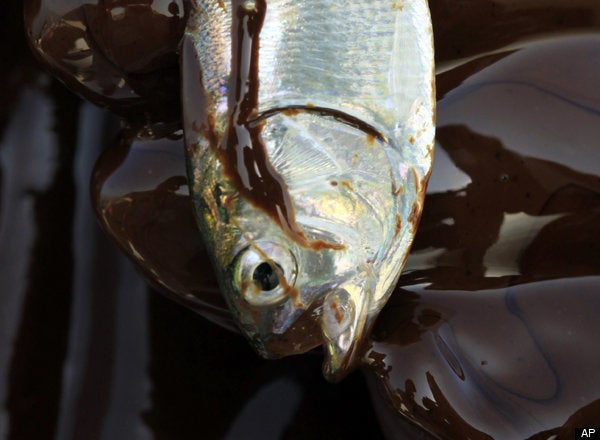
The combination of oil and dispersants is no more toxic to sea life than oil alone, the Environmental Protection Agency announced Monday after conducting a new, but very limited, round of tests.
The EPA was responding in part to concerns raised by some scientists that adding dispersant to oil has actually made the resulting mix more toxic than oil alone. BP applied almost 2 million gallons of dispersant to the oil its blown-out well spewed into the Gulf of Mexico.
But EPA's test, conducted on just two kinds of sea animals -- one species of shrimp, and one species of small fish -- only tested to see how much of a substance was necessary to kill them.
That means the experiment doesn't resolve concerns about long term effects -- or even medium-term effects. What happens when the shrimp or fish eat enough dispersed oil to make them sick, but not die? Or what about prolonged exposure? And what about the sea turtles?
Indeed, an agency spokesman e-mailed me: "This study focused on short-term, acute toxicological effects of oil and dispersant-oil mixtures. This study did not examine the mechanisms of toxicity. Oil ingestion was difficult to observe in the larval forms of both species used in this series of acute tests and signs of ingestion were not overtly apparent."
Similarly, the test doesn't resolve concerns that breaking up the oil into tiny droplets makes it more likely to enter the food chain -- a scenario that appears more likely now that scientists at Tulane University have found signs of an oil-and-dispersant mix under the shells of tiny blue crab larvae all over the Gulf of Mexico. A lot of larger sea animals eat crab larvae.
Here's what the EPA spokesman had to say about that: "The purpose of dispersant application is to disperse the oil into smaller droplets which facilitates biodegradation, remove floating oil from the surface, and thus reducing the volume of oil reaching important shoreline habitats like wetlands, marshes, beaches and estuaries. EPA has no evidence that dispersants are entering the food chain. The FDA, USDA and NOAA are continuing to investigate these issues."
The test called for oil and dispersant to be mixed energetically, but it didn't necessarily recreate the mixing that took place in this spill, where the dispersant was being pumped directly into into a geyser of intensely hot crude oil and gas shooting into frigid water under 7000 pound per square inch of pressure.
Susan Shaw, the director of the Marine Environmental Research Institute and the leader of a group of scientists concerned about the oil-dispersant mix, called Monday's announcement by the EPA "a defensive move to make them look in control." It was the Coast Guard, not the EPA, that called the shots when it came to dispersant application.
She said testing two species is not enough. "There are at least 15.000 marine species in the Gulf that could be impacted by the dispersed oil."
And she noted that the EPA completely failed to address the concern that dispersants can increase the uptake of oil by organisms, because the same properties that allow them to disperse oil also make it easier for them to move through cell walls and other protective barriers.
The EPA test involved mixtures of Lousiana Sweet Crude oil and eight dispersants, including Corexit 9500A. BP applied 1.8 million gallons of Corexit as part of its spill response. The test did find that one dispersant, Nokomis 3-AA, when mixed with oil was more toxic than oil itself. That dispersant was not used on the Gulf spill.
"EPA recognizes that dispersant usage is an environmental tradeoff not to be taken lightly," said Paul Anastas, EPA's assistant administrator for research and development. But, he said: "The good thing about the current scenario is we are seeing the oil in a place where it can be biodegraded by the natural biodegrading process that takes place."
